- All
- Product Name
- Product Keyword
- Product Model
- Product Summary
- Product Description
- Multi Field Search

The high-precision ball screw is an indispensable component within wafer handling robots, directly enabling the precise and reliable Z-axis motion that is fundamental to modern semiconductor manufacturing. It is a key enabler of throughput and yield in fab operations.If your wafer handling robots or other semiconductor equipment require high-performance, dependable ball screw solutions, LMT is positioned to be your ideal partner.

In the field of automation where ultra-high efficiency and speed are pursued, ball screws are typically the preferred choice. However, in the semiconductor industry, which demands ultimate cleanliness, stability, and reliability, the seemingly traditional lead screw, with its unique advantages, plays an irreplaceable role in critical equipment such as SMIF Openers. This article will delve into how lead screws meet the extreme demands of semiconductor manufacturing.

This article introduces LMT's precision lead screw assemblies, engineered specifically for high-performance surgical lighting arms. It highlights key features that address the critical demands of the operating room, including maintenance-free operation with self-adjusting backlash and dry-film lubrication, ensuring precision positioning and eliminating the risk of contamination. The text also emphasizes the components' compact design, exceptional durability, corrosion resistance, and ultra-quiet performance, presenting them as a core solution for reliable, long-lasting, and precise surgical illumination.

Lifting columns leverage advanced linear drive technology, converting the rotational motion of motors into linear motion of push rods through precision mechanical structures. This enables smooth, precise height and position adjustments for various equipment, furniture, or workstations.

Lifting AGV robots are a common type of automated logistics equipment currently used in manufacturing enterprises, primarily for material transportation and handling tasks.

Design and Preparation:LMT engineers can design prototypes of lead screws for customers.Based on product requirements and specifications,designs are created,and required materials and tools are determined.

In the field of modern mechanical transmission, lead screw is used as a core component to convert rotary motion into linear motion.The progress of its manufacturing process directly affects the performance of equipment and production costs. Among them, rolled leadscrews stand out with the following

A precision lead screw for high-performance semiconductor chip wedge bonders,comprising a lead screw body,a nut meshed with the surface of the lead screw body,and protective covers fixedly connected to both left and right ends of the lead screw body.

Harnessing every possible ray of sunlight is paramount for the efficiency of large-scale solar power plants.This is where sophisticated solar tracker systems come into play,constantly adjusting the angle of photovoltaic panels or mirrors to follow the sun's path across the sky.

The selection between lead screws and ball screws hinges on critical distinctions in their structure,operational principles,and performance characteristics.

Ever stared at a ball screw or lead screw assembly,wondering exactly how each part contributes to that precise,powerful motion?This blog post cuts through the complexity.

A lead screw is a fundamental mechanical component designed for power transmission and precision linear motion. Its core structure consists of a threaded screw shaft and a matching nut.

LMT company actively organized its technicians to participate in the Suzhou"Land of Wu Craftsmen" Vocational Skills Competition Series,co-hosted by the Suzhou Industrial Park Trade Union,Human Resources and Social Security Bureau,and Suzhou Technician College.

At the Congress,LMT engaged with thousands of executives and engineers from leading companies.Through its booth,we showcased cutting-edge core technologies to establish high-value business partnerships.

Lead screws are essential components for power transmission and precise linear motion.The manufacturing process directly impacts their performance,accuracy,and cost-effectiveness.Cold rolling,turning,and grinding represent the three primary methods,each offering distinct advantages.

Clamping element is widely used in many aspects of machining,assembly and inspection.Its main role is to fix the workpiece to ensure the stability and accuracy of the workpiece during machining.The selection of clamps has a direct impact on productivity and machining quality.

Recently, the Suzhou Hi-Tech Zone Intelligent Manufacturing Industry Association organized representatives from 3 key enterprises within the zone to visit LMT Group,a benchmark manufacturer in the industry.

Clamping elements(often referred to as clamps or brakes)are essential,high-performance components designed to work seamlessly with linear guides and linear shaft.Here are their primary advantages:Enhanced Rigidity & Vibration SuppressionIntegrating a clamp into your machine structure significantly b

Linear Guide Clamp: The Invisible Guardian in Industrial AutomationIn the realm of industrial automation,the efficient operation of equipment relies on precise motion control systems.As a core component of linear guide systems,the clamping element is often overlooked,yet it plays a pivotal role in e

Lead screws are one of the most common and cost-effective tools used to convert rotary motion into linear motion.Advanced materials and coatings allow them to be used in a variety of applications,such as semiconductor manufacturing,medical,food processing and textiles.